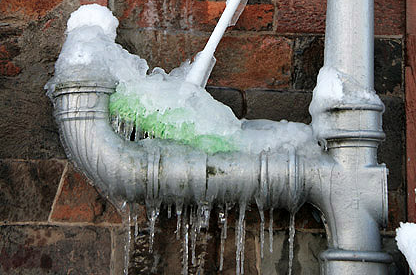Ways to Defend Your Pipes from Cold Weather: Professional Guidance
Ways to Defend Your Pipes from Cold Weather: Professional Guidance
Blog Article
What are your concepts on Helpful Tips to Prevent Frozen Pipes this Winter?
:strip_icc()/snow-outdoor-faucet-pipes-4af65d1e5e904fb1aa7bf74071fe5d89.jpg)
Cold weather can wreak havoc on your plumbing, specifically by freezing pipelines. Here's exactly how to avoid it from taking place and what to do if it does.
Introduction
As temperature levels drop, the risk of icy pipes increases, potentially bring about pricey repair work and water damage. Recognizing exactly how to avoid frozen pipes is critical for house owners in cool climates.
Avoidance Tips
Insulating susceptible pipes
Wrap pipes in insulation sleeves or utilize warm tape to protect them from freezing temperatures. Concentrate on pipelines in unheated or outside locations of the home.
Home heating techniques
Keep interior rooms properly heated, specifically areas with plumbing. Open cupboard doors to allow warm air to flow around pipes under sinks.
Exactly how to recognize icy pipes
Seek reduced water circulation from faucets, uncommon odors or noises from pipes, and visible frost on exposed pipelines.
Long-Term Solutions
Structural adjustments
Take into consideration rerouting pipes far from exterior walls or unheated areas. Include added insulation to attic rooms, basements, and crawl spaces.
Updating insulation
Buy top notch insulation for pipes, attic rooms, and wall surfaces. Correct insulation assists keep regular temperatures and minimizes the risk of icy pipes.
Securing Outdoor Pipes
Garden hose pipes and outside faucets
Separate and drain pipes yard hose pipes before winter months. Set up frost-proof spigots or cover outside faucets with protected caps.
Recognizing Icy Pipelines
What causes pipes to ice up?
Pipelines ice up when revealed to temperature levels listed below 32 ° F (0 ° C) for extended periods. As water inside the pipelines freezes, it expands, taxing the pipeline walls and potentially triggering them to burst.
Dangers and problems
Icy pipelines can cause water supply disruptions, property damages, and costly repairs. Ruptured pipes can flooding homes and trigger comprehensive architectural damage.
Indications of Frozen Pipes
Recognizing frozen pipelines early can stop them from rupturing.
What to Do If Your Pipelines Freeze
Immediate actions to take
If you believe frozen pipes, keep faucets open to ease pressure as the ice thaws. Use a hairdryer or towels taken in hot water to thaw pipelines gradually.
Conclusion
Protecting against icy pipelines calls for aggressive steps and quick responses. By understanding the causes, signs, and safety nets, property owners can secure their pipes throughout winter.
5 Ways to Prevent Frozen Pipes
Drain Outdoor Faucets and Disconnect Hoses
First, close the shut-off valve that controls the flow of water in the pipe to your outdoor faucet. Then, head outside to disconnect and drain your hose and open the outdoor faucet to allow the water to completely drain out of the line. Turn off the faucet when done. Finally, head back to the shut-off valve and drain the remaining water inside the pipe into a bucket or container. Additionally, if you have a home irrigation system, you should consider hiring an expert to clear the system of water each year.
Insulate Pipes
One of the best and most cost-effective methods for preventing frozen water pipes is to wrap your pipes with insulation. This is especially important for areas in your home that aren’t exposed to heat, such as an attic. We suggest using foam sleeves, which can typically be found at your local hardware store.
Keep Heat Running at 65
Your pipes are located inside your walls, and the temperature there is much colder than the rest of the house. To prevent your pipes from freezing, The Insurance Information Institute suggests that you keep your home heated to at least 65 degrees, even when traveling. You may want to invest in smart devices that can keep an eye on the temperature in your home while you’re away.
Leave Water Dripping
Moving water — even a small trickle — can prevent ice from forming inside your pipes. When freezing temps are imminent, start a drip of water from all faucets that serve exposed pipes. Leaving a few faucets running will also help relieve pressure inside the pipes and help prevent a rupture if the water inside freezes.
Open Cupboard Doors
Warm your kitchen and bathroom pipes by opening cupboards and vanities. You should also leave your interior doors ajar to help warm air circulate evenly throughout your home.

Do you appreciate reading up on Helpful Tips to Prevent Frozen Pipes this Winter? Create a remark directly below. We'd be happy to listen to your suggestions about this write up. We hope to see you back again before long. Loved our write-up? Please share it. Help another person discover it. I praise you for being here. Kindly stop by our website back soon.
Schedule Appointment Now Report this page